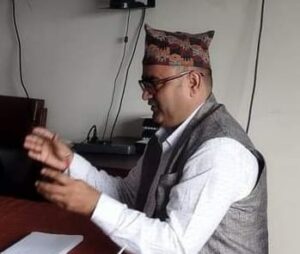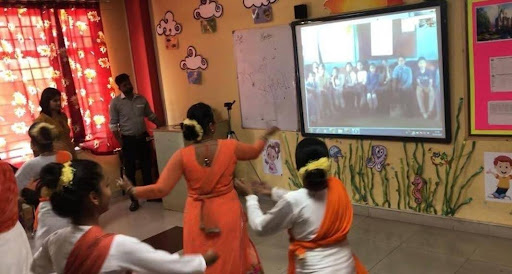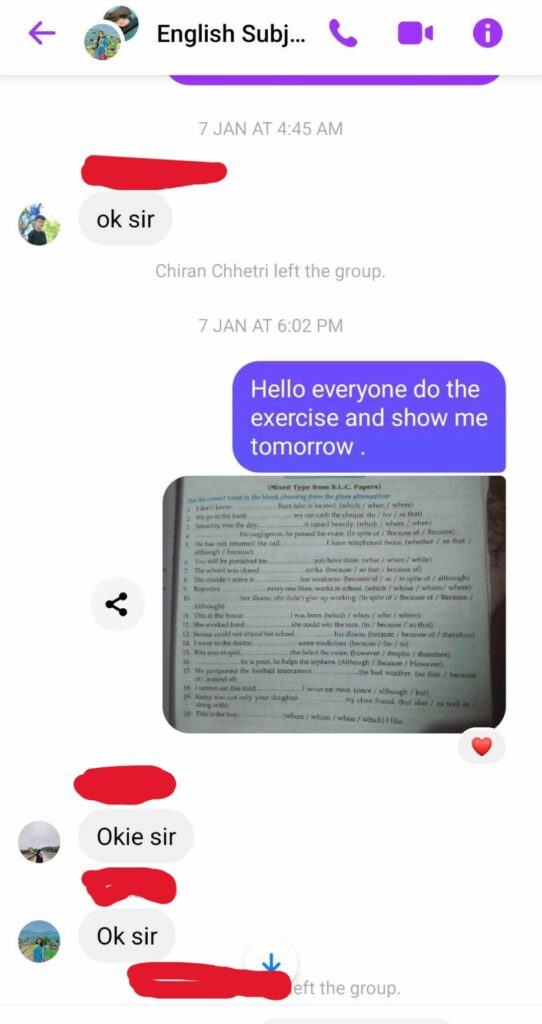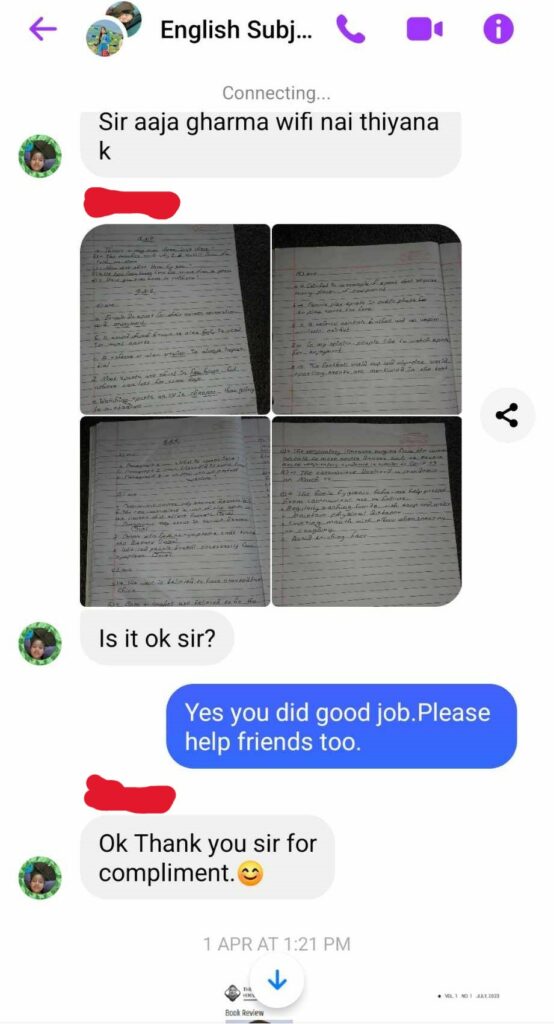
English Medium Instruction (EMI) is a global phenomenon, expanding rapidly across the world due to the influence of neoliberalism, instrumentalism, and the ideology of English as a global language. In Nepal, EMI has become a widely adopted medium of instruction policy, both in institutional and community schools. Consequently, many resarchers are studying various dimensions of EMI, both globally and in Nepal. In light of this, ELT Choutari has decided to publish a special issue focusing on “EMI Policies and Practices in Nepal” for its third quarterly edition (July-September 2024). This issue features the valuable insights and experiences of four distinguished scholars who have been actively researching and supervising EMI topics from diverse perspectives at universities both in Nepal and abroad. We have invited Associate Professor Dr. Bal Krishna Sharma from the University of Idaho, USA, Prof. Dr. Bal Mukunda Bhandari, Prof. Dr. Tara Datta Bhatta, and Prof. Dr. Binod Luitel from Tribhuvan University to share their thoughts on various dimensions of EMI from a research standpoint. Our Issue Editor, Nani Babu Ghimire had an interview with them. Specifically, Mr. Ghimire has gathered their opinions and views on EMI based on three key questions.
Question: Given the growing number of scholars researching EMI, why do you consider EMI a significant and researchable issue at the moment?
Associate Prof. Dr. Sharma:
Whether you accept it or not, many countries and societies, including Nepal, are increasingly viewing English as a language of globalization, internationalization, transnational mobility, and a symbol of social prestige. However, many of these perceptions are based on myths, as the practical benefits of English proficiency often fall short of expectations. The adoption of EMI, particularly in countries like Nepal, is founded on the mistaken belief that it leads to better job opportunities, higher university rankings, and miraculous improvements in student achievement and educational quality. Nanibabu-ji, your research actually points out the issue to that direction. In reality, you discuss that much of this push for EMI originates from top-down policymaking influenced by stakeholders who may not thoroughly consider research findings. These stakeholders hold the belief that EMI offers specific advantages to universities and students, often driven by financial motives. Nepali parents and students must understand whether EMI genuinely delivers the benefits that policymakers and school administrators claim. Further studies are essential to assess whether EMI genuinely enhances students’ English proficiency. If not, introducing a foreign language can have adverse effects. For instance, imagine a student struggling to understand Nepali history because the instruction is in English, despite Nepal having Nepali and numerous other languages that could effectively facilitate learning. Even if instruction in every language is impractical, utilizing multiple languages can enrich content learning.
Prof. Dr. Bhandari:
Many non-English speaking countries have been providing education in English to attract foreign students… EMI is the main concern of academic subjects like Science and Mathematics or Finance and Economics; however, the English language teaching professionals and researchers are found more interested into this issue. When the modern schooling started in Nepal, the English language has been a part of education system either as a subject or the medium of instruction. Private schools have always preferred EMI and marked themselves different from other schooling systems in Nepal.
EMI was adopted along with the global spread of English in many countries of the world; however, it has been in discussion in the recent decades. In the context of Nepal, only after the government/ community schools started to switch themselves into English medium schools or they opened a wing as English medium, voices in support or against EMI have been raised. These voices about EMI have made this issue researchable.
Prof. Dr. Bhatta:
English Medium Instruction (EMI) has significantly drawn the attention among scholars and policymakers in Nepal due to its multifaceted and multi-dimensional impact on education and society. Research on EMI is thus crucial as it helps assess the alignment of Nepal’s educational policies with global standards and measures the effectiveness of EMI in equipping students with the necessary skills for global engagement.
In the same vein, the adoption of EMI in Nepal is influenced by complex socio-cultural factors. Historically, English has been associated with prestige and socio-economic advancement, a legacy of colonial education systems. Parents and students in Nepal often view EMI as a pathway to improved educational outcomes and enhanced career prospects. This perception is supported by the belief that proficiency in English—language capital—can open doors to better job opportunities and social mobility. Research into these motivations provides valuable insights into the socio-cultural drivers of EMI adoption and highlights the need to address both the perceived benefits and the potential drawbacks of this instructional approach.
Nepal’s rich linguistic diversity poses significant challenges for the implementation of EMI. With over 126 languages spoken across the country, the practicalities of delivering instruction in English while accommodating multiple native languages are complex in the heterogeneous classroom contexts. Research should focus on how EMI can be effectively implemented without undermining Nepal’s linguistic and cultural heritage. This involves exploring models that support bilingual or multilingual education and ensure that local languages are preserved alongside the promotion of English proficiency.
Educational equity is a critical concern in the context of EMI. While EMI aims to provide students with valuable English language skills, it may unintentionally worsen existing educational inequalities. Students from affluent backgrounds often have better access to high-quality EMI programmes and resources, whereas those from disadvantaged backgrounds may face significant barriers. Research into the impact of EMI on educational equity is essential for developing policies and practices that ensure fair access to quality education for all students. This includes investigating the effectiveness of targeted support mechanisms for students from lower socio-economic backgrounds and evaluating the role of government and institutional policies in promoting educational equity.
The integration of EMI into Nepal’s education system raises important questions about balancing globalization with the preservation of cultural identities. While EMI offers opportunities for global engagement and economic advancement, it also risks overshadowing local languages and traditions. Research should explore strategies for implementing EMI in a way that respects and integrates Nepal’s cultural and linguistic diversity. This involves developing educational models that allow students to benefit from global competencies while also valuing and preserving their cultural heritage.
In this sense, EMI has been emerging as a significant and researchable issue in the present era and considerable number of scholars from various universities of Nepal have been persuading their research on EMI.
Prof. Dr. Luitel:
In the contemporary scenario, as we know, there has been the craze for English considering its role as the international ‘lingua franca’. This is the language most widely being employed in association with international business, diplomacy, scientific-technological innovations, and various sorts of communicative exchanges from one corner to other corners of the globe – that can include social, cultural, and academic concerns.
In this context, academic institutions offering education from the lower to the higher levels are attracted towards employing English for running educational programmes; and people are also tempted towards educating their children through English – with the strong conviction that enabling their children to effectively communicate the contents in this language is the most fundamental criterion for their success. Despite the pedagogical reality that educating the children through mother tongue in the beginning years of schooling becomes the most effective way of their learning, schools have offered teaching-learning materials and organized the curricular and extra-curricular activities through English.
Basically, the issue of adopting EMI in the schools of Nepal should be considered from two angles: English medium at the level of formal requirements; and English medium at the level of classroom proceedings. When a school adopts English medium in using the textbooks and conducts examinations through English, the case is the use of EMI as part of formal requirements. Regarding EMI at the level of pedagogical practices, it should be implemented in the classroom proceedings when the teachers and students adopt it as if they are ‘immersed’ into English, without necessarily depending on the students’ native language or any other language.
EMI research, in the context of Nepal in particular, should be considered a very important field of exploration from these perspectives. It is essential to explore, how far English has been adopted as the medium of instruction at both the levels just mentioned – i.e. whether it is practiced at the level of using English medium textbooks and conducting the exams through English, or at the level of ‘immersed’ classroom pedagogy as well. In addition, there is also the need for researching the level of intellectual knowledge and insights gained by the younger children educated through EMI in comparison to those who have been educated through mother tongue or the national lingua franca (Nepali). Moreover, several issues related to parents’ perceptions, teachers’ competence, curricular materials are important for exploring the implementation of EMI in the context of Nepal.
Question: Based on your experiences, what aspects of EMI have recently been explored by novice scholars in Nepal?
Associate Prof. Dr. Sharma:
I find it challenging to pinpoint research outputs from novice scholars for several reasons. It’s known that novice scholars often collaborate with more senior researchers throughout the research process, writing, and publication phases. Both you and I have done this in various degrees and these outcomes from our colleagues and us have appeared in diverse formats such as journals (e.g., Journal of English Medium Instruction), edited volumes, handbooks, and region-specific publications. From my understanding, several areas have gained prominence within the EMI sub-field: EMI and higher education, EMI and translanguaging, and EMI and social justice, to name just a few. In higher education and EMI, researchers are exploring pedagogical practices to identify effective teaching strategies, methodologies, and assessment practices that balance content learning with language proficiency. Moreover, there is a growing interest in studying student outcomes to understand how EMI impacts academic performance, linguistic challenges, and long-term professional trajectories. Also, translanguaging, which involves the dynamic use of multiple languages by bilingual or multilingual speakers, provides a valuable framework for understanding EMI practices. By acknowledging learners’ entire linguistic repertoire, translanguaging is believed to promote a holistic approach to language learning. This allows students in EMI settings to use their native languages to understand and engage with content more deeply. Furthermore, researchers and practitioners both believe that translanguaging validates students’ cultural identities by boosting their confidence and motivation (Phyak et al., 2022; Sah & Li, 2022). There is a need for further exploration on how to effectively integrate this aspect into EMI frameworks. Finally, some research has raised concerns about social justice and inequalities stemming from EMI programs, particularly in multilingual societies like ours (Sah & Karki, 2020). There has been significant progress in critical applied linguistics through the works of scholars such as Suresh Canagarajah, Ryuko Kubota, Alaistair Pennycook, and others, who emphasize that language serves as a political tool influencing social identities and language ideologies—critical elements in language education and EMI today. Therefore, it is essential to continue examining the broader impacts of EMI on societies and individuals, particularly those on the margins (e.g., Indigenous language speakers, working-class people). Evidence indicates that EMI may be fostering or exacerbating educational and social elitism, a significant concern highlighted in research by Pramod Sah and also observed across various cultural contexts, including China, South Korea, and Hong Kong. It is important to acknowledge that if English becomes an additional barrier preventing students from accessing educational opportunities, it poses a serious issue that requires urgent attention. While not entirely avoidable, understanding and addressing these issues is essential to ensure that EMI contributes positively to educational equity and social inclusivity.
Prof. Dr. Bhandari:
EMI is a hot topic of research at present in Nepal. Though we find this topic in the reports, dissertations, and journal articles, it is yet to be understood from different facets. The researchers have so far tried to explore the policies and practices of EMI in the government schools from the stakeholders’ opinions who may not have sufficient understanding of it (Karki, 2023). On the other hand, I am not aware of any research in which an EMI teacher has been directly involved. The research with the already designed framework with limited informants may not bring the ground reality which can only capture the tip of the ice.
The findings so far have explained that EMI is the demand of the society, parents, and students therefore it is important and necessary (Ghimire, 2019; Phyak, 2016; Sah & Karki, 2020). They have also explored the challenges such as training teachers to teach in English, proper management from the side of the schools and extra financial burden for the parents.
Prof. Dr. Bhatta:
As I have above said, considerable number of scholars from various universities of Nepal have been persuading their studies on EMI. Most of the research they have made have highlighted the importance of teacher proficiency in EMI settings (Ojha, 2018). Many studies have identified gaps in teachers’ language skills and pedagogical practices, revealing that inadequate training can hinder the effectiveness of EMI. In this regard, novice scholars have explored how current professional development programmes address these challenges and proposed improvements to better equip teachers for EMI environments (Khatri, 2019).
Another area of research on EMI made by the research is the understanding the perceptions and attitudes of stakeholders—teachers, parents, students, and policymakers. Recent research has explored how these groups view EMI and their reasons for supporting or opposing it. Findings often indicate that while many stakeholders recognize the benefits of EMI for English language acquisition, there are concerns about its potential negative effects on students’ understanding of other subjects and cultural identity (Phyak & Sharma, 2020). Investigating these perceptions helps to identify areas of consensus and conflict, informing strategies for addressing stakeholder concerns and improving EMI implementation.
Similarly, the impact of EMI on student learning outcomes is a significant focus of recent research. Studies have investigated whether EMI improves English language skills and overall academic performance (Dearden, 2014). Results are mixed, with some students benefiting from EMI while others face challenges due to language barriers. This highlights the need for additional support mechanisms, such as remedial classes and differentiated instruction, to ensure that all students can thrive in EMI settings. Research in this area helps to identify best practices and interventions that can enhance the effectiveness of EMI and support diverse learning needs.
Moreover, recent research has examined how socioeconomic and linguistic factors affect students’ experiences with EMI. Studies have shown that students from lower socio-economic backgrounds and those with limited English proficiency may struggle more in EMI settings. This highlights the need for inclusive policies and practices that address these barriers and promote equitable access to EMI. Research should focus on identifying strategies to support students from disadvantaged backgrounds and ensure that EMI serves as a tool for educational equity rather than perpetuating existing inequalities.
The development of curricula and instructional materials for EMI has been another area of exploration. Scholars have investigated how to design curricula that effectively integrate English language learning with subject content. This includes evaluating the quality and relevance of textbooks and digital resources used in EMI settings. Research in this area advocates for curricula that are not only effective in teaching English but also culturally responsive and contextually appropriate for Nepal’s diverse student population.
The role of technology in enhancing EMI has been explored to assess how digital tools can support language learning and instructional practices. Research has examined the use of online platforms, language learning apps, and other technological resources in EMI settings. Many scholars have been working on EMI for their MPhil or PhD dissertations.
Prof. Dr. Luitel:
One of the issues picked up by the scholars for exploration in this regard is related to the parents’ temptation towards EMI and the social perception towards it (Ghimire, 2024). In the context of a developing country like Nepal, social perception towards EMI has been associated with ‘prestige’ to some extent. Accordingly, teachers teaching in schools through English medium are regarded with higher prestige compared to others who do not use EMI. Thus, EMI in relation to teachers’ and students’ social identify has been the matter of exploration to some extent.
Practically speaking, in the context of community schools, there are the cases of adopting EMI as well as abandoning EMI due to various reasons; and researchers’ interest in identifying the factors associated with these opposing cases have also been the concerns for exploration in Nepal. From such explorations, it is identified that schools are tempted to adopt EMI to address the demand of parents and for their own institutional sustenance; and they tend to abandon EMI if the teaching staffs cannot handle it due to the lack of competence and confidence required for instructional delivery through English.
Equally, there is also the interest among scholars regarding the use of students’ home language or the national language (Nepali) while teaching English. One of the realities in the context of second language teaching-learning is that the learner comes to learn this language with some already pre-occupied language which s/he deploys in the course of learning anything new. This psychological reality has several dimensions that need to be explored furthermore.
Question: Reflecting on your own practice and engagement in EMI research, which areas of EMI do you believe need further exploration in the future?
Associate Prof. Dr. Sharma:
I am still learning more about this topic, but based on my review so far, I identify three primary areas that need more attention in EMI research now and in the future. First, EMI and Content and Language Integrated Learning (CLIL) have been largely treated as distinct areas of research until today; however, they share overlapping goals and principles. EMI focuses on teaching academic subjects in English in contexts where English is not the first language, primarily aiming to enhance students’ language proficiency and academic success in English. CLIL, on the other hand, integrates content and language learning simultaneously; it emphasizes both subject mastery and language acquisition through a dual-focused approach. Despite their different origins and emphases, both EMI and CLIL seek to improve students’ academic outcomes and language skills. I strongly believe that integrating findings from both fields or having researchers from these seemingly different lines of research collaborate could be beneficial. Insights from CLIL’s methodologies on balancing language and content objectives can inform EMI practices; this can ensure that students not only learn the subject matter but also develop their English proficiency effectively. Conversely, research from EMI can provide CLIL practitioners with strategies for addressing academic language needs. This integration has the potential to enhance pedagogical practices and improve student outcomes, especially in contexts like ours where there is a growing emphasis on developing English abilities alongside content knowledge. At the same time, I believe it is crucial to collaborate with content area teachers and researchers; to my knowledge, very few studies involve partnerships with subject specialists and practitioners; this is the case not only in Nepal, but globally,
Second, I have read more about EMI research in the Nepali context, which repeatedly points out that “teachers are not well-trained to teach content subjects in English,” as highlighted by our own wonderful researchers including Prem Phyak (and myself), Pramod Sah, Jeevan Karki, Nani Babu Ghimire, Tek Mani Karki, Mohan Singh Saud and others. Future research should examine in more detail the design and implementation of teacher preparation and professional development programs, which are crucial for ensuring effective educational outcomes. There are hardly any formal programs that support our teachers at the grassroots level. It is essential to move beyond basic training and ask what types of professional development programs are most effective in bringing about meaningful changes in teaching practices. Effective programs should address not only language proficiency but also pedagogical skills to effectively teach content. Researchers can collaborate with practitioners and curriculum developers to offer ongoing support, such as mentorship and reflective teacher development, to help them refine their practices. In this sense, researchers have more responsibility than simply “understanding” the EMI phenomenon; because they often come with knowledge of best practices from other contexts, they can effectively work with teachers to localize effective EMI practices and strategies. Perhaps you could be an example for this through your doctoral research and participation in teacher development programs.
Finally, the integration of technology and artificial intelligence (AI) in EMI could be another potential area of exploration. It’s proven that technology can provide innovative tools and platforms that support both teaching and learning in EMI contexts, with an emphasis on language and content. For instance, AI-driven language learning applications can offer personalized language practice, instant feedback, and adaptive learning paths tailored to individual student needs. Students and teachers can utilize this dimension for content learning as well. I understand that the digital divide between the poor and rich is wide in Nepal, but in contexts where technology is already integrated into education, practitioners can bridge these interfaces.
My best hope is that greater research and policy focus will be directed towards the thousands of children compelled to learn in English from their first year of primary school, as we see in Nepal and in many other world contexts. For me, there remains a pressing need for a detailed understanding of how English-medium instruction affects these children’s language identity, their access to content and the curriculum, and their overall literacy and language development across all languages.
Prof. Dr. Bhandari:
Seeing private schools performing better in the school level tests such as SEE, and also higher education, the parents and other stakeholders understood English as the instrument for better/standard education. They have not explored other aspects of EMI management. In addition to the medium, there are several determining factors that play crucial roles for imparting quality education. Most of the researchers have come up with the findings that in the name of EMI, English medium books are used but the classroom delivery is not in English, and the school environment is the same whatever the medium is (Ghimire, 2019; Gim, 2020). The studies have also reported that many community schools were not successful to run English medium education, and thus turning back to Nepali medium. The notion of successful education has to be properly defined, and it should be seen in the real life of the graduates. Despite the challenges, EMI has many implications which should/could be the area of research. Furthermore, the practice of language policy and planning in other countries may help manage EMI in Nepal.
Prof. Dr. Bhatta:
As it is an emerging area of study as well as the interest of many people, there are lots of areas for further exploration in the future.
One of them includes longitudinal studies to assess the long-term effects of EMI on students’ educational and career outcomes. While current research often focuses on immediate impacts, understanding how EMI influences students’ academic achievements and professional trajectories over time is crucial. Longitudinal studies can provide valuable insights into the sustained benefits and challenges of EMI, helping educators and policymakers develop strategies that support students throughout their academic and professional careers.
Another research is needed to explore how EMI affects cognitive development. While some studies suggest that bilingualism associated with EMI can enhance cognitive skills, there are concerns about cognitive overload, particularly for younger students (Phyak et al., 2022). Investigating how EMI impacts cognitive processes such as problem-solving, memory, and attention can provide a deeper understanding of its effects on cognitive development and inform instructional practices that optimize learning outcomes.
Similarly, the impact of EMI on teachers’ professional identities and roles warrants further exploration. Teachers in EMI settings often face unique challenges in balancing language instruction with content delivery. Research should examine how EMI affects teachers’ perceptions of their roles, job satisfaction, and instructional practices. Understanding these dynamics can provide insights into the support and professional development needed to enhance teachers’ effectiveness and well-being in EMI contexts.
Given Nepal’s linguistic diversity, exploring how EMI intersects with multilingual education policies is essential. Research should investigate how EMI can be integrated into frameworks that support multilingualism, allowing students to develop proficiency in English while also valuing their native languages and other national languages. This includes examining models of bilingual or trilingual education that balance global competencies with local linguistic and cultural identities.
The socio-cultural implications of EMI on students and communities need further exploration. Research should investigate how EMI influences social cohesion, cultural values, and identity formation. Understanding how EMI affects students’ perceptions of their cultural heritage and social interactions within their communities can guide the development of policies that respect and celebrate Nepal’s cultural diversity while promoting global competencies.
Future research should focus on innovative pedagogical practices that enhance EMI effectiveness. This includes exploring instructional strategies, assessment methods, and classroom management techniques tailored to EMI settings. Research should identify best practices that promote active learning, critical thinking, and student engagement. This involves investigating the role of technology, collaborative learning, and culturally responsive teaching methods in improving EMI outcomes.
Prof. Dr. Luitel:
In the contemporary context when EMI schools are ‘mushrooming’ in the country, there are a few issues and concerns that deserve attention in research. One of them is related to the compatibility of EMI with the institutional capability in terms of teachers’ competence to handle it in particular (Ghimire, 2021; Karki, 2018; Ojha, 2018; Poudel, 2019). Similarly, the matter of linguistic complexity and content related qualities of the input offered in the materials (textbooks) is of prime importance for exploration.
Most importantly, I have noted the issue of developing our students’ linguistic capability and communicative competence as per the national development needs. In this regard, the crucial matter is related to how far we are preparing the students to serve the purpose of transferring the knowledge and insights from English to Nepali and vice-versa. We need the future citizens who can grasp the world knowledge through English and communicate it into Nepali for national benefit as well as ones who can effectively describe and disseminate the contents gathered or generated in Nepali to the world for making the country well-known to the rest parts of the globe. In doing the jobs in both ways, we need the committed citizens who can work for national interest.
In this connection, promotion of bilingual education is highly important; and in EMI research, the researchers should be concerned more about how far the policies and practices of EMI have been (or can be) instrumental towards promoting bilingual competence among the students in the schools of Nepal. This concern is related to the issue of learners’ competence in L1-L2 (Nepali-English) bridging – which has been my area of interest in research and innovations in the field of language pedagogy.
References
Dearden, J. (2014). English as a medium of instruction – a growing global phenomenon. British Council. https://tinyurl.com/2vx3v6ds
Ghimire, K. P. (2024). Perceptions on English as a Medium of Instruction in Community School in Nepal. KMC Journal, 6(1), 176–191. https://doi.org/10.3126/kmcj.v6i1.62339
Ghimire, N. B. (2019). English as a medium of instruction: Students’ discernment in Nepal. Education and Development, 29, 146–160.
Ghimire, N. B. (2021). Teacher identity in English medium instruction schools of Nepal. Journal of NELTA Gandaki, 4(1-2), 42–56.
Gim, S. J. (2020). Nepali teacher identity and English medium education: The impact of the shift to English as the medium of instruction at Nepali public schools on teacher identity (Publication No. 28257970) [Doctoral dissertation, Biola University]. Proquest Dissertations and Theses Global.
Karki, J. (2018). Is English medium instruction working? A case study of Nepalese community schools in Mt. Everest Region. In D. Hayes (Ed.), English language teaching in Nepal: Research, reflection and practice (pp. 201–218). British Council. https://tinyurl.com/2ppw3972
Karki, T. M. (2023). English as a medium of instruction in community schools of Nepal: Policies and practices [Unpublished docotral dissertation]. Tribhuvan University, Faculty of Education, Kathmandu.
Khatri, K. K. (2019). Teachers’ attitudes towards English as medium of instruction. Journal of NELTA Gandaki, 2, 43–54. https://doi.org/10.3126/jong.v2i0.26602
Ojha, L. P. (2018). Shifting the medium of instruction to English in community schools: Policies, practices and challenges in Nepal. In D. Hayes (Ed.), English language teaching in Nepal: Research, reflection and practice (pp. 187–200). British Council. https://tinyurl.com/2ppw3972
Phyak, P. B. (2016). ‘For our cho: Tlung’: Decolonizing language ideologies and (re) imagining multilingual education policies and practices Nepal (Publication No. 10587361) [Doctoral dissertation, University of Hawaii]. ProQuest Dissertations and Theses Global.
Phyak, P. B., Sah, P. K., Ghimire, N. B., & Lama, A. (2022). Teacher agency in creating a translingual space in Nepal’s multilingual English-medium schools. RELC Journal, 53(2), 431–451. https://doi.org/10.1177/00336882221113950
Phyak, P. B., & Sharma, B. K. (2020). Functionality of English in language education policies and practices in Nepal. In R. A. Giri, A. Sharma, & J. D’Angelo (Eds.), Functional variations in English (pp. 321–335). Springer. https://doi.org/10.1007/978-3-030-52225-4_21
Poudel, P. P. (2019). The medium of instruction policy in Nepal: Towards critical engagement on the ideological and pedagogical debate. Journal of Language Education, 5(3), 102–110. https://doi.org/10.17323/ jle.2019.8995
Sah, P. K., & Karki, J. (2020). Elite appropriation of English as a medium of instruction policy and epistemic inequalities in Himalayan schools. Journal of Multilingual and Multicultural Development, 44(1), 20–34. https://doi.org/10.1080/01434632.2020.1789154
Sah, P. K., & Li, G. (2022). Translanguaging or unequal languaging? Unfolding the plurilingual discourse of English medium instruction policy in Nepal’s public schools. International Journal of Bilingual Education and Bilingualism, 25(6), 2075–2094.
Like this:
Like Loading...




























